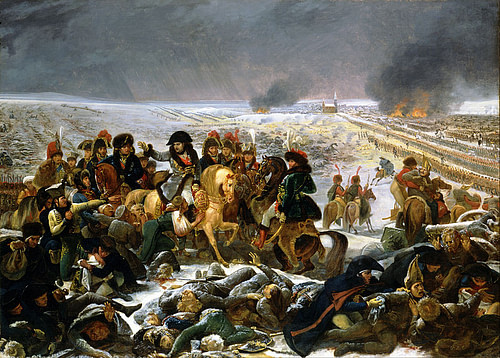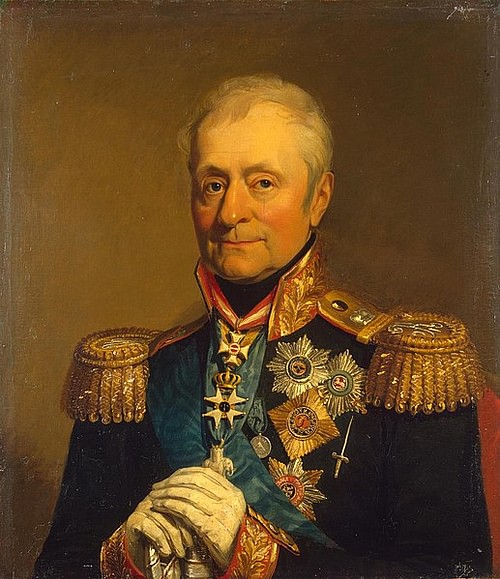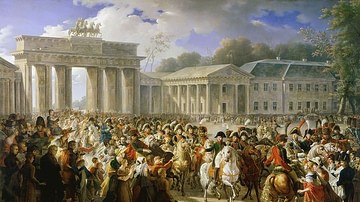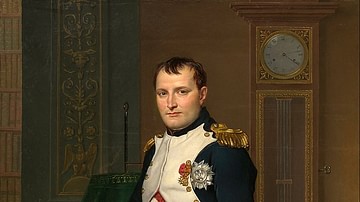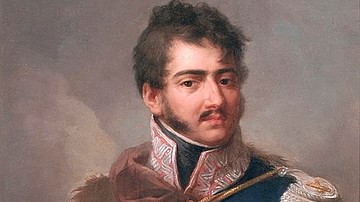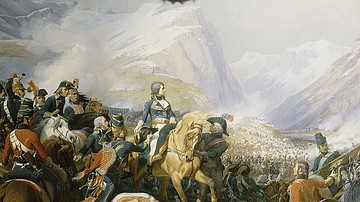The Battle of Friedland (14 June 1807) was a decisive battle of the Napoleonic Wars (1803-1815), fought by the armies of the French and Russian empires. A major French victory, Friedland caused the Russians to sue for peace, resulting in the Treaties of Tilsit and the end of the War of the Fourth Coalition (1806-1807).
Background
In October 1806, the War of the Fourth Coalition began when Prussia, eager to reassert its authority in Central Europe, declared war on the First French Empire. Emperor Napoleon I (r. 1804-1814; 1815), whose mighty 180,000-man Grande Armée had wintered in southern Germany, was quick to respond. On 8 October, the French crossed over into Saxony, where they defeated the main Prussian army at the double Battle of Jena-Auerstedt (14 October). For hours after the battle, the retreating Prussian soldiers were mercilessly pursued and cut down by the French Cavalry Reserve under Marshal Joachim Murat. On 25 October, French soldiers entered the Prussian capital of Berlin, forcing King Frederick William III of Prussia (r. 1797-1840) to flee to the safety of Königsberg in East Prussia (modern Kaliningrad, Russia). Though the Prussians refused to admit defeat, they had effectively been knocked out of the war.
Napoleon next invaded Prussian-occupied Poland and entered Warsaw on 19 December, where he was hailed as a liberator. The three partitions of Poland (in 1772, 1793, and 1795) had deprived Poland of its nationhood, its lands carved up between Prussia, Russia, and Austria. Though Napoleon was careful not to make any explicit promises, he relished his role as Poland's deliverer and saw the value in establishing a loyal French client state in Eastern Europe. He established a provisional, semi-autonomous political entity, consisting of six Polish departments and governed by a council of seven Polish noblemen. This laid the groundwork for the Grand Duchy of Warsaw, which would be established the following year.
Having secured the support of Polish patriots, Napoleon ordered his men across the Vistula River to engage the armies of his next enemy, Russia. The Russian Empire had been continuously at war with France since 1805; despite suffering a stinging defeat at the Battle of Austerlitz (2 December 1805), Tsar Alexander I of Russia (r. 1801-1825) had elected to fight on. Though the Russian army had not been able to support Prussia before its rapid defeat, it now prepared to salvage the war by preventing the French from taking Königsberg or advancing into Russian territory.
On 23 December, as they were fording the River Wkra, French soldiers clashed with the Russians at the Battle of Czarnowo, which was followed by the larger battles of Pułtusk and Gołymin, both fought on 26 December. Despite their heavy cost in human lives, none of these engagements proved decisive. With the onset of a bitter Polish winter, both the French and Russian armies withdrew into winter quarters.
Battle of Eylau
As Napoleon wintered in the city of Warsaw (where he began a famous affair with the young and beautiful Countess Marie Walewska), his miserable soldiers shivered in their cantonments along the Vistula. By early January 1807, supplies were running dangerously low for the French VI Corps under Marshal Michel Ney. Despite being under strict orders to stay put until spring, Ney decided to move his corps out of winter quarters and strike north, hoping to seize the supply depot near Königsberg.
Ney stumbled upon the Russian army on 17 January. The Russians had left their winter quarters to launch a surprise attack on the French and were moving west through the Forest of Johannisberg, using the dense woodlands to shield their movements from French scouts. Ney quickly informed Napoleon, who ordered the Grande Armée to immediately march north. The French emperor saw a chance to trap the Russian army; as they moved further west, the Russians would inevitably expose their flank to a French attack. However, the commander-in-chief of the Russian army, the German-born Count Levin August von Bennigsen, soon learned of Napoleon's planned counterattack and moved his army back across the Alle River. The French pursued, and the two armies clashed on 7 February 1807, in the town of Preussisch-Eylau.
The Battle of Eylau had likely begun by accident; French soldiers who entered the town to secure shelter and provisions encountered a Russian patrol, and a small skirmish blossomed into a full-blown battle as both sides poured more soldiers into the fray. Thousands of men were killed or wounded in a bloody struggle near the Eylau cemetery, but by nightfall, Eylau itself was in French hands, as the Russians pulled back to the heights east of the town. A heavy blizzard began at midnight and continued throughout the morning, as the second day of fighting opened with an artillery duel between the two armies. Hoping to pin down the Russians until additional reinforcements could arrive, Napoleon sent the corps of marshals Jean-de-Dieu Soult and Charles-Pierre Augereau to attack the Russian lines. Both corps were badly mauled and were pushed back to Eylau.
The Russians pursued the French into the town, and Napoleon himself was nearly captured in the street-to-street fighting. The day was saved by Marshal Murat, who led a massive cavalry charge of 11,000 men that broke through the Russian center. Fighting continued throughout the day, but the arrival of Ney's Corps of 14,500 fresh troops finally convinced Bennigsen to withdraw. Though the field belonged to Napoleon, the battle was a bloody stalemate; neither side had won any advantage, and each army had lost around 25,000 casualties. This outcome is best summed up by Ney's reaction the next morning: "What a massacre! And without any result!" (Roberts, 445). After Eylau, both sides withdrew back into winter quarters: the French along the Passarge River, the Russians along the Alle.
The Campaign Resumes
Eylau was the first time the Grande Armée had experienced anything other than complete victory, and the French troops had become severely demoralized. Instead of the familiar, triumphant cries of "Vive l'Empereur", Napoleon was greeted by frustrated soldiers shouting for "Pain et paix!" ("Bread and peace"). The emperor did his best to raise their spirits, requisitioning rye, wheat, bread, meat, horses, and, most importantly, shoes from his nearest Polish and German allies. But the soldiers were still suffering, and Napoleon knew he had to give them a victory once the fighting season resumed. He called upon his allies for reinforcements, raising new levies of 10,000 Bavarians, 15,000 Spaniards, and 6,000 Poles. Napoleon also called up the French 1808 class of conscripts a year early.
On 24 May 1807, after months of stagnation, Napoleon received some good news; the Prussian city of Danzig (Gdańsk) had fallen to the French troops of Marshal François-Joseph Lefebvre. Glad to publicize a much-needed victory, Napoleon ordered Te Deums sung back in Paris and awarded Lefebvre the title 'Duke of Danzig'. By now, the French emperor was ready to resume the campaign. With around 123,000 infantry, 30,000 cavalry, and 5,000 artillery gunners at hand, Napoleon set 10 June as the date he would begin his offensive. However, as had happened in January, the Russians beat him to the punch. On 5 June, Bennigsen attacked Ney's Corps at the Battle of Guttstadt-Deppen. With the help of three additional French corps, Ney managed to throw back the Russian assault, though Marshal Jean Bernadotte was wounded in the head by a musket ball.
Battle of Heilsberg
Napoleon was still very much in the dark as to Bennigsen's numbers and intentions; the only thing he was certain of was that the Russians were using Königsberg as their base. Hoping to cut Bennigsen off from Königsberg, Napoleon allowed a messenger to be captured by the Russians, carrying fake dispatches that claimed 40,000 French soldiers were preparing to attack the Russian rear. Falling for the ruse, the Russians retreated to their well-fortified encampment at Heilsberg, along the Alle River. Napoleon pursued; in his haste, he believed that only the Russian rearguard was at Heilsberg and that the bulk of Bennigsen's army was retreating toward Königsberg. On the morning of 10 June, Napoleon ordered an attack, only to learn that he was not just facing the enemy rearguard, but Bennigsen's entire army of 53,000 men.
The heights on each side of the Alle were strongly fortified and were occupied by Bennigsen's nine divisions. French Marshal Murat opened the Battle of Heilsberg when he led his Cavalry Reserve toward the Russian positions; though he drove back the Russian advance posts, his charge was bogged down by a bombardment from Russian artillery. French Marshal Soult's Corps moved up to assist, but it, too, came under heavy fire from the Russian guns under Grand Duke Constantine, the tsar's brother. Napoleon personally arrived on the field at 3 p.m., furious at his subordinates for botching the attack and having lost three Imperial Eagle standards. At 10 p.m., Marshal Jean Lannes' V Corps attempted a night assault and paid heavily for its recklessness with the loss of 2,200 men. The battle was over an hour later, the French having lost 10,000 men without gaining any advantage. The Russians sustained around 8,000 casualties.
Though the Battle of Heilsberg was a tactical victory for the Russians, they would have little time to bask in their success. Pressed by the approaching French corps of Louis-Nicolas Davout and Édouard Mortier, Bennigsen was forced to withdraw before he could be surrounded, and the French occupied the blood-stained Heilsberg Heights on 12 June. Unwilling to let the Russians get away, Napoleon dispatched 60,000 men to capture Königsberg while he led the other 80,000 men back to Eylau. On 13 June, Lannes' advance scouts reported seeing large numbers of Russian troops crossing the Alle at the town of Friedland (modern Pravdinsk, Russia), a "mid-sized town nestling in the U-bend" of the river, situated around 50 kilometers (30 mi) southwest of Königsberg (Roberts, 451). In a prime example of the effectiveness of the corps system, Marshal Lannes engaged the Russians with the intention of fixing them in place until the main army could arrive. For nine hours, Lannes' men battled the Russians, as Bennigsen poured more men back across the Alle to dislodge him. At 6 p.m., 3,000 Russian cavalry finally pushed Lannes away from the village.
Though most of Bennigsen's army was now on the wrong side of the river, he remained confident that he could crush Lannes the next morning and recross the Alle before Napoleon could arrive from Eylau, some 25 kilometers (15 mi) away, but in underestimating Napoleon's speed, he had made a grave mistake.
Battle of Friedland Begins
The battlefield of Friedland is described by historian Andrew Roberts:
The Alle curves around Friedland, enveloping the town to the south and the east while a lake called the Millstream flanks it to the north. The Alle is deep and fast flowing, its banks over 30 feet high. In front of the town was a broad, fertile plain nearly two miles wide, waist-deep in wheat and rye, abutted by a dense forest known as Sortlack Wood. The Millstream, which also has steep banks, divides the plain. (451)
By 3:30 in the morning on 14 June 1807, Bennigsen had constructed four pontoon bridges across the Alle and was hurrying men across, though Lannes soon resumed his attack to pin down as many Russians as he could. Around this time, the first elements of Napoleon's main army began to arrive on the scene – General Nicolas Oudinot's grenadiers arrived to capture the outlying village of Posthenen, followed closely by French dragoons under General Emmanuel de Grouchy. The Russian batteries greeted these new arrivals with heavy cannonades, though Oudinot's men took shelter in Sortlack Wood, where they began skirmishing with Russian troops.
As dawn began to break, Lannes' objective was still to keep as many Russian troops on the left side of the river as possible; he had noticed that the Russian pontoon bridges lay far beyond Bennigsen's left flank, meaning that if he could cut the Russians off from the bridges, they would be trapped in Friedland between the French army and the Alle River. What he needed now was time. At 7 a.m., Lannes sent Grouchy to secure the French rear by seizing the town of Heinrichsdorf, which Grouchy achieved after beating back the Russian defenders. The rest of the morning saw only sporadic fighting, as Lannes placed a thick line of skirmishers amongst the tall crops, marching the rest of his troops in and out of the woods to exaggerate the size of his corps; he still only had 9,000 infantry and 8,000 cavalry against six Russian divisions that were busy deploying around the Millstream. Bennigsen had between 50-60,000 men.
At 9:30 a.m., just as Bennigsen's forces finished deploying and were preparing to attack, French Marshal Mortier's VIII Corps arrived, bumping Lannes' numbers up to 35,000 men. Within half an hour, 40,000 French were on the field. Bennigsen now realized the gravity of the situation; before long, Napoleon himself would arrive. His new plan was to hold the French off until nightfall, at which point he hoped to slip back across the river.
Napoleon Takes Command
Shortly before midday, Napoleon and his staff arrived to relieve Lannes from command; the French now had 80,000 men, outnumbering the Russians. A lull had descended over the battle, and the emperor's staff was divided over whether to resume the attack today or wait until the next morning. Napoleon had spotted an error in Bennigsen's deployment; the Russian left flank was vulnerable to being pushed up against the river. Moreover, the Russian army was practically split in two by the Millstream, meaning that one wing would be unlikely to support the other. The emperor, therefore, refused to postpone his attack, remarking, "We won't catch the enemy making the same mistake twice" (Roberts, 454). 14 June was the seventh anniversary of Napoleon's victory at the Battle of Marengo, and prone to superstitions, Napoleon was seen pacing up and down, hitting the tall weeds with his riding crop and muttering, "Marengo day. Victory day" (ibid).
At 5 p.m., the battle resumed. The emperor ordered a concentrated attack on the vulnerable Russian left. Ney was to move through Sortlack Wood to attack the Russian flank and was ordered to destroy two of the pontoon bridges. Lannes was to continue holding the center while Mortier would deploy near Heinrichsdorf, threatening the enemy's right flank. 20 salvoes from the French artillery signaled the start of Ney's attack. At the head of 10,000 men, Ney swept through Sortlack, clearing it within an hour.
The sight of the French troops emerging from the woods alarmed the Russians; as one observer described the sight of the thousands of French bayonets, "the horizon seemed to be bound by a deep girdle of glimmering steel" (ibid). Ney's men slammed into the Russian left, pushing scores of Russians into the river. Hoping to salvage his left, Bennigsen launched a cavalry counterattack, but before Ney's Corps broke, it was reinforced by the fresh French I Corps led by General Claude-Victor Perrin.

Victor's counterattack forced the Russian cavalry back toward the infantry, which was in a disorderly position along the peninsula. Noticing the mass of Russians clumped together, Victor ordered forward his cannons. Led by the artillery general Sénarmont, the French guns moved forward in a veritable 'artillery charge'; Sénarmont's guns started at 1,450 meters (1,600 yards), then advanced to 550 meters (600 yards) where they unlimbered and fired before limbering back up and moving up to 275 meters (300 yards). This process continued until Sénarmont's guns were only 55 meters (60 yards) away from the clustered Russian troops, at which point the French were able to fire off grapeshot. The Russian cavalry charged the artillery but was torn to bloody ribbons by grapeshot; within 25 minutes, some 4,000 Russian horsemen had fallen.
Covered by Sénarmont's artillery, Ney managed to rally his corps and break through the Russian left flank, charging into Friedland itself. Brutal hand-to-hand fighting broke out in the streets of Friedland, which soon caught fire. Lannes and Mortier, meanwhile, had beaten back a desperate attack from the Russian center and had countercharged, pressing the Russians back up against the river. By now, three of the four pontoon bridges had been destroyed, and many Russians drowned as they tried to flee. However, some Russians discovered a ford, which allowed enough of them to cross the river to establish a battery on the right bank. This battery provided covering fire, allowing Bennigsen to evacuate as many men as he could across the ford. By 11 p.m., the battle was over; the exhausted French soldiers failed to pursue, more interested in pillaging Friedland for food.
Aftermath
The Battle of Friedland was the decisive French victory that Eylau was not. Though the French had lost around 8,000 men, the Russians had suffered between 18-20,000 losses, 30% of Bennigsen's entire army. Four days later, Tsar Alexander asked for an armistice, which Napoleon happily granted. The Treaties of Tilsit, signed a month later, ended the War of the Fourth Coalition and established an uneasy Franco-Russian alliance. Despite the mutual distrust between the two empires, France and Russia would remain at peace for five years, until deteriorating relations led to Napoleon's invasion of Russia in 1812.


